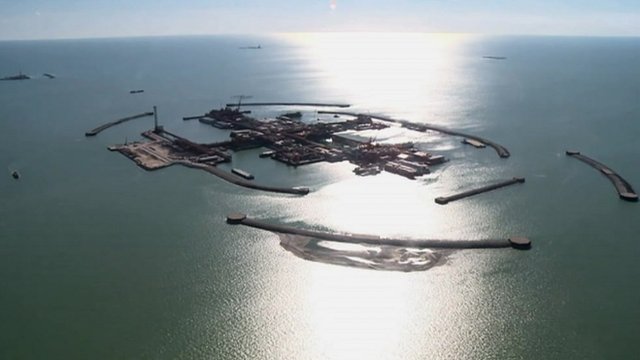
Kazakhstan’s Kashagan Oil Project Set to Start Commercial Production
Publication: Eurasia Daily Monitor Volume: 10 Issue: 166
By:

The international consortium developing Kazakhstan’s super-giant offshore oilfield Kashagan is now on course to start commercial production by October 1, the final deadline set by Kazakhstan’s government. Meeting that deadline will enable the consortium to avoid financial penalties that the government could have imposed in the event of non-compliance with that deadline.
Commercial oil production actually started on September 10 as “test runs” at certain wellheads of the Kashagan project. Kazakhstan’s government is now reassured that the project consortium is meeting the start deadline. The government apparently defines the level of commercial production as 75,000 barrels per day (bpd) on average for the remainder of 2013. The production rate has reached 40,000 bpd at the moment and keeps rising. The consortium has taken necessary measures to continue production during the winter despite severe climatic conditions at the site (Kazinform, Trend, September 18).
Kashagan ranks as the richest oil deposit discovered worldwide since the finding of the Prudhoe Bay field in Alaska in the late 1960s. Kashagan’s reserves (combined with two smaller adjacent fields) are estimated at 35–38 billion barrels of oil-in-place, including 9–13 billion barrels of recoverable oil (nearly 5 billion tons in-place, including 1.6 billion tons recoverable, on the median estimates) (Kazinform, Trend, September 18). Along with the giant Tengiz and Karachaganak fields, which are currently ramping up their production, the Kashagan project is set to propel Kazakhstan into the ranks of leading oil producing countries on a global scale.
The project consortium, North Caspian Operating Company (NCOC, www.ncoc.kz) is comprised of Kazakhstan’s state oil and gas company Kazmunaigaz, Italian Agip (subsidiary of Italian ENI), ExxonMobil of the United States, Royal Dutch Shell, and Total of France, with 16.81 percent of the shares each; Inpex of Japan with 7.56 percent; and the Houston, Texas-based ConocoPhillips with 8.33 percent, currently being bought out by China’s National Petroleum Corporation (CNPC).
Kazakhstan exercised its right of pre-emption to buy ConocoPhillips’s stake, after the American company had offered to sell it to India’s state-controlled Oil & Natural Gas Corporation. Instead, Kazakhstan decided in July to re-sell that stake to CNPC for approximately $5 billion (see EDM, July 9). On September 7, in Astana, the heads of Kazmunaigaz and CNPC signed the final sale-and-purchase agreement, in the presence of Kazakhstan’s President Nursultan Nazarbayev and the visiting Chinese President Xi Jinping. The Chinese side has further agreed to contribute $3 billion toward Kazmunaigaz’s share of investment in the second phase of Kashagan’s project development, according to Kazmunaigaz head Sauat Mynbayev (Reuters, September 8).
Kashagan ranks not only as the richest oil discovery worldwide in recent decades, but possibly also as the most challenging and most expensive oil project. Extreme pressure in the oil flow at the wells, toxic gases mixed with the oil, roving ice flows in the northern Caspian Sea in winter, and recurrent gale-force winds pose safety risks, necessitating expensive protection measures. The complexities of geology and climate have resulted in repeated delays of commercial production and cost overruns. Exploration and development started in 2000, with the launch of commercial production envisaged over-optimistically for 2005. Field development proceeded at a somewhat steadier pace after Italian Agip agreed to share the project’s operatorship with three other partners in the NCOC consortium.
The consortium’s investments are estimated at $40 billion from inception to date, including ancillary projects. The Bolashak oil-treatment plant for example, operational since July 2013 (ahead of the start of Kashagan production), alone cost $4 billion to build. It is designed to separate sulfur and gases from Kashagan oil, prior to its delivery into pipelines for export. The Bolashak plant’s processing capacity at full throttle will be 450,000 bpd (or 22 million tons of oil per year) (see EDM, July 9).
Current plans envisage production targets of 180,000 bpd during 2014, rising to 370,000 bpd by 2015, with a steady ramp-up to 1.6 bpd from 2016 onward.
Four export routes are available for Kashagan oil production. Each participant company will export its production quota in its own right, independently of the other partners in the consortium. The front-runner option seems to be the Caspian Pipeline Consortium’s (CPC) export pipeline from Kazakhstan to Russia’s Black Sea port of Novorossiysk, for onward shipment by tankers to international markets. The CPC is currently expanding its capacity to handle Kashagan, Tengiz, and Karachaganak oil volumes. Companies that have not invested in CPC and not reserved CPC capacities have a poorer export option through the Atyrau-Samara pipeline, again to Russia. The Chinese will undoubtedly prefer to ship their oil quota from Kashagan through the existing Atasu-Alashankou pipeline, directly to China. The CNPC and Kazakhstan intend to increase this line’s capacity, and certain Kashagan shareholders consider using this pipeline to initiate oil sales to China. A fourth option, according to Kazmunaigaz’s Mynbayev, remains the shipment of small volumes of Kashagan oil from Kazakhstan’s port of Aktau, across the Caspian Sea to Azerbaijan (Trend, September 17).
These export options, if implemented as currently envisaged—particularly if the capacity of the CPC pipeline to Novorossiysk is doubled to 65 million tons per year as planned—could result in a net increase of already heavy reliance on Russia for transiting the oil produced in Kazakhstan to international markets.




